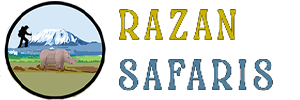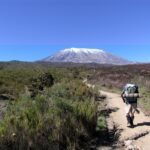Climb Kilimanjaro : How Difficult is it to Climb Kilimanjaro ? : Mount Kilimanjaro is a fair difficult mountain to climb – recent research suggests that over 50% of those who attempt it suffer from mountain sickness and just over 65% of them are unable to reach the summit
The reasons behind this high number of unsuccessful attempts vary, from issues caused by the altitude to the mindset of the climber.
Kilimanjaro is an extreme altitude mountain trek. Measuring 19,341 feet, or 5,895 meters, you will need to prepare well and train before attempting to climb Kili.

Climbing Kilimanjaro most days are not very hard because the trails are not steep it’s mostly dealing with the altitude, however the summit night is extremely difficulty as this is the coldest, windiest section of your adventure.
An ascent of 4,084ft with 49% less oxygen and a descent of nearly 6,870ft. It can take up to 12-14 hours of walking.
A common question we get asked all the time, and we see a lot in the various forums, is how hard is it to climb Kilimanjaro? The answer to this question is a bit complicated, as it depends on many factors, and is very individual.
After all, what one person finds “hard”, another may find “easy”. And because something is hard, doesn’t that make it all the more satisfying to do?
Many people have said “Kilimanjaro is the hardest thing I’ve ever done especially the summit night and then gone on to do it again. We’ve yet to meet someone who thinks it’s “easy”, but it always depends on what you’re comparing with.
Compared with Everest, Kilimanjaro is “easy”.
Compared with a leisurely walk along the beach, it’s “hard”.
Let’s dig in to some of the specific factors that affect whether Kilimanjaro is hard – or not – and what you can do about it.
How Difficult is it to Climb Kilimanjaro ? : Climbing Kilimanjaro Technical Difficulty
One of the first questions that inexperienced, aspiring mountaineers want to know, is whether there is any technical difficulty involved when climbing Kilimanjaro.
Mount Kilimanjaro isn’t a hard trek in terms of technicality, its a “walk-up”, a trekking peak that can be done without an ice axe, ropes, or harnesses. You don’t need any technical mountaineering skills at all.
How Difficult is it to Climb Kilimanjaro ? : Dealing with Altitude Difficulty on Kilimanjaro
This is really one of the hardest part of climbing Kilimanjaro. Your ability to acclimatize and get used to the low oxygen in the air – while still having to trek long distances – is what sets Kilimanjaro apart from your average long day’s hiking. Kilimanjaro Altitude training is one of the preparations you can do to maximize your chances of being able to handle the altitude, but it can be a bit unpredictable.
Taking a long route – 6+ days – will give your body more time to acclimatize, and give time for adequate rest and recovery, as you won’t be in a hurry to make up the miles.









Thanks for sharing. I read many of your blog posts, cool, your blog is very good.
Your article helped me a lot, is there any more related content? Thanks!
A person necessarily help to make significantly posts I might state. This is the first time I frequented your web page and up to now? I amazed with the analysis you made to make this particular post incredible. Magnificent job!
Can you be more specific about the content of your article? After reading it, I still have some doubts. Hope you can help me.
Your article helped me a lot, is there any more related content? Thanks!
This is a very good tips especially to those new to blogosphere, brief and accurate information… Thanks for sharing this one. A must read article.
I liked as much as you will obtain carried out right here. The cartoon is tasteful, your authored subject matter stylish. however, you command get got an shakiness over that you wish be handing over the following. ill indisputably come further until now again since exactly the same just about a lot ceaselessly inside of case you protect this increase.
Good day I am so grateful I found your blog, I really found you by accident, while I was looking on Google for something else, Nonetheless I am here now and would just like to say cheers for a incredible post and a all round entertaining blog (I also love the theme/design), I don’t have time to browse it all at the minute but I have book-marked it and also included your RSS feeds, so when I have time I will be back to read much more, Please do keep up the great work.
You made some good points there. I looked on the internet for the topic and found most guys will go along with with your blog.
Somebody essentially help to make seriously posts I would state. This is the first time I frequented your website page and thus far? I amazed with the research you made to create this particular publish amazing. Wonderful job!
Way cool, some valid points! I appreciate you making this article available, the rest of the site is also high quality. Have a fun.
I visited a lot of website but I think this one has something special in it in it
Thank you for your sharing. I am worried that I lack creative ideas. It is your article that makes me full of hope. Thank you. But, I have a question, can you help me?
I don’t think the title of your article matches the content lol. Just kidding, mainly because I had some doubts after reading the article.
Thank you for your sharing. I am worried that I lack creative ideas. It is your article that makes me full of hope. Thank you. But, I have a question, can you help me?
Thank you for your sharing. I am worried that I lack creative ideas. It is your article that makes me full of hope. Thank you. But, I have a question, can you help me?
Thanks for sharing. I read many of your blog posts, cool, your blog is very good.
Thank you for your sharing. I am worried that I lack creative ideas. It is your article that makes me full of hope. Thank you. But, I have a question, can you help me?
Can you be more specific about the content of your article? After reading it, I still have some doubts. Hope you can help me.
Your article helped me a lot, is there any more related content? Thanks!
A code promo 1xBet est un moyen populaire pour les parieurs d’obtenir des bonus exclusifs sur la plateforme de paris en ligne 1xBet. Ces codes promotionnels offrent divers avantages tels que des bonus de dépôt, des paris gratuits, et des réductions spéciales pour les nouveaux joueurs ainsi que les utilisateurs réguliers.code promo 1xbet davido
Keep up the fantastic work! Kalorifer Sobası odun, kömür, pelet gibi yakıtlarla çalışan ve ısıtma işlevi gören bir soba türüdür. Kalorifer Sobası içindeki yakıtın yanmasıyla oluşan ısıyı doğrudan çevresine yayar ve aynı zamanda suyun ısınmasını sağlar.